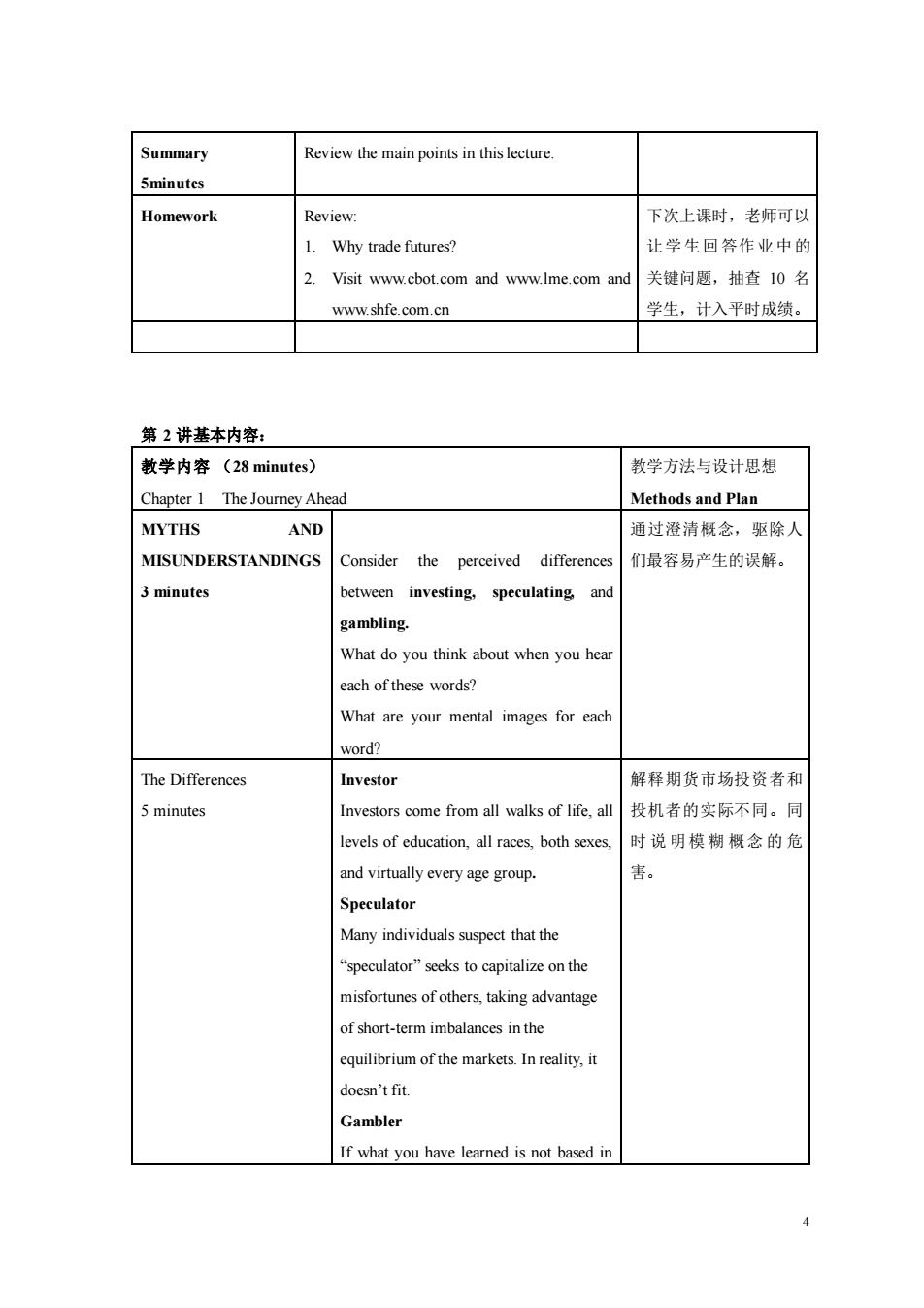
Summary Review the main points in this lecture. 5minutes Homework Review 下次上课时,老师可以 1.Why trade futures? 让学生回答作业中的 2.Visit www.cbot.com and www.lme.com and关键问题,抽查10名 www.shfe.com.cn 学生,计入平时成绩。 第2讲基本内容: 教学内容(28 minutes). 教学方法与设计思想 Chapter 1 The Journey Ahead Methods and Plan MYTHS AND 通过澄清概念,驱除人 MISUNDERSTANDINGS Consider the perceived differences 们最容易产生的误解。 3 minutes between investing,speculating and gambling. What do you think about when you hear each of these words? What are your mental images for each word? The Differences Investor 解释期货市场投资者和 5 minutes Investors come from all walks of life,all 投机者的实际不同。同 levels of education,all races,both sexes, 时说明模糊概念的危 and virtually every age group. 害。 Speculator Many individuals suspect that the “"speculator”seeks to capitalize on the misfortunes of others.taking advantage of short-term imbalances in the of the markets.In reality.it doesn't fit Gambler If what you have learned is not based in 4
4 Summary 5minutes Review the main points in this lecture. Homework Review: 1. Why trade futures? 2. Visit www.cbot.com and www.lme.com and www.shfe.com.cn 下次上课时,老师可以 让学生回答作业中的 关键问题,抽查 10 名 学生,计入平时成绩。 第 2 讲基本内容: 教学内容 (28 minutes) Chapter 1 The Journey Ahead 教学方法与设计思想 Methods and Plan MYTHS AND MISUNDERSTANDINGS 3 minutes Consider the perceived differences between investing, speculating, and gambling. What do you think about when you hear each of these words? What are your mental images for each word? 通过澄清概念,驱除人 们最容易产生的误解。 The Differences 5 minutes Investor Investors come from all walks of life, all levels of education, all races, both sexes, and virtually every age group. Speculator Many individuals suspect that the “speculator” seeks to capitalize on the misfortunes of others, taking advantage of short-term imbalances in the equilibrium of the markets. In reality, it doesn’t fit. Gambler If what you have learned is not based in 解释期货市场投资者和 投机者的实际不同。同 时 说 明模 糊 概念 的 危 害
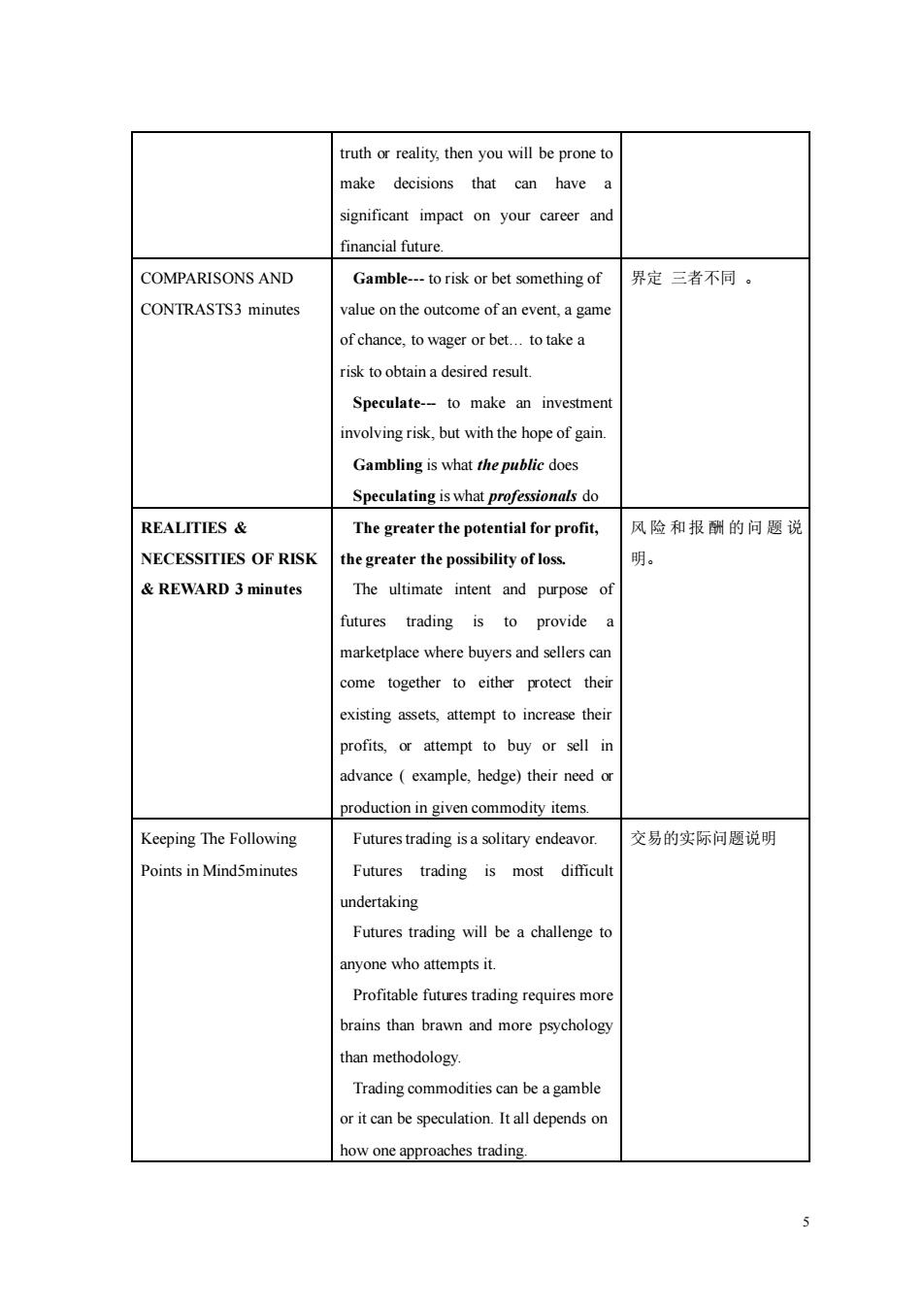
truth or reality,then you will be prone to make decisions that can have a significant impact on your career and financial future. COMPARISONS AND Gamble-to risk or bet something of 界定三者不同。 CONTRASTS3 minutes value on the outcome of an event,a game of chance,to wager or bet.to take a risk toobtain a desired result Speculate-to make an investment involving risk.but with the hope of gain Gambling is what the public does Speculating iswhat professionals do REALITIES The greater the potential for profit, 风险和报酬的问题说 NECESSITIES OF RISK the greater the possibility of loss. 明。 REWARD 3 minutes The ultimate intent and purpose of futures trading is to provide a marketplace where buyers and sellers can come together to either protect thei existing assets,attempt to increase their profits,or attempt to buy or sell in advance example.hedge)their need or production in given commodity items. Keeping The Following Futures trading isa soliary endeavor. 交易的实际问题说明 Points in Mind5minutes Futures trading is most difficul undertaking Futures trading will be a challenge to anyone who attempts it. Profitable futures trading requires more brains than brawn and more psychology than methodology. Trading commodities can be a gamble or it can be speculation.Itall depends on how one approaches trading
5 truth or reality, then you will be prone to make decisions that can have a significant impact on your career and financial future. COMPARISONS AND CONTRASTS3 minutes Gamble- to risk or bet something of value on the outcome of an event, a game of chance, to wager or bet. to take a risk to obtain a desired result. Speculate- to make an investment involving risk, but with the hope of gain. Gambling is what the public does Speculating is what professionals do 界定 三者不同 。 REALITIES & NECESSITIES OF RISK & REWARD 3 minutes The greater the potential for profit, the greater the possibility of loss. The ultimate intent and purpose of futures trading is to provide a marketplace where buyers and sellers can come together to either protect their existing assets, attempt to increase their profits, or attempt to buy or sell in advance ( example, hedge) their need or production in given commodity items. 风险和报 酬 的问 题 说 明。 Keeping The Following Points in Mind5minutes Futures trading is a solitary endeavor. Futures trading is most difficult undertaking Futures trading will be a challenge to anyone who attempts it. Profitable futures trading requires more brains than brawn and more psychology than methodology. Trading commodities can be a gamble or it can be speculation. It all depends on how one approaches trading. 交易的实际问题说明
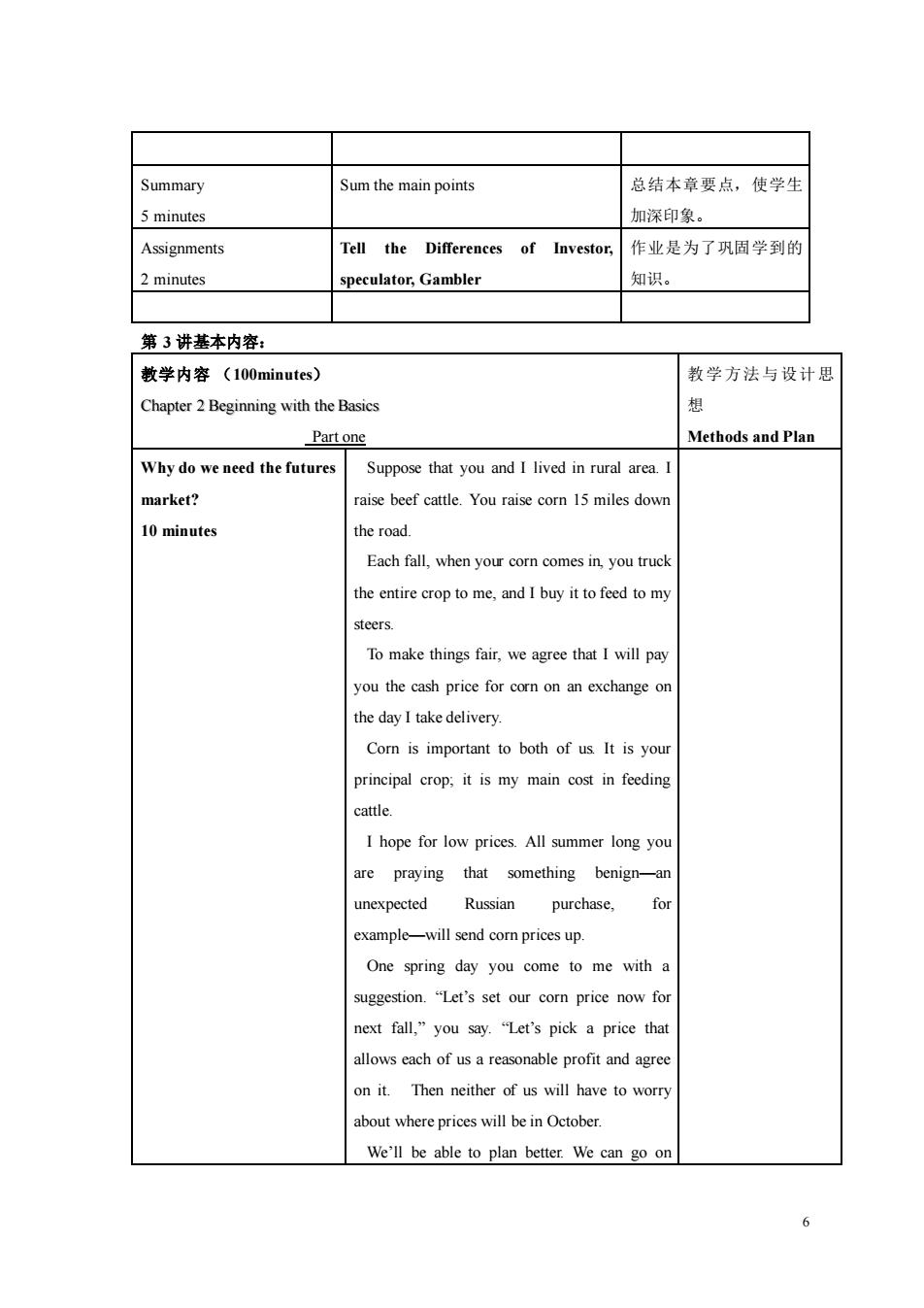
Summary Sum the main points 总结本章要点,使学生 加深印象。 Assignments Tell the Differences of Investor. 作业是为了巩固学到的 2 minutes speculator,Gambler 知识。 第3讲基本内容: 教学内容(100 minutes) 教学方法与设计思 Chapter 2 Beginning with the Basics Part onc Methods and Plan Why do we need the futures Suppose that you and I lived in rural area.I market? raise beef cattle.You raise corn 15 miles down 10 minutes the road. Each fall,when your corn comes in,you truck the entire crop to me.and I buy it tofeed tomy steers. To make things fair,we agree that I will pay you the cash price for corn on an exchange on the day I take delivery. Corn is important to both of us It is your principal erop.it is my main cost in feeding cattle. I hope for low prices.All summer long you are praying that something benign-an unexpected Russian purchase, for example-will send corn prices up. One spring day you come to me with a suggestion."Let's set our corn price now for next fall,”you say.气et's pick a price tha allows each of us a reasonable profit and agree on it Then neither of us will have to worry about where prices will be in October. We'll be able to plan better.We can go on 6
6 Summary 5 minutes Sum the main points 总结本章要点,使学生 加深印象。 Assignments 2 minutes Tell the Differences of Investor, speculator, Gambler 作业是为了巩固学到的 知识。 第 3 讲基本内容: 教学内容 (100minutes) Chapter 2 Beginning with the Basics Part one 教学方法与设计思 想 Methods and Plan Why do we need the futures market? 10 minutes Suppose that you and I lived in rural area. I raise beef cattle. You raise corn 15 miles down the road. Each fall, when your corn comes in, you truck the entire crop to me, and I buy it to feed to my steers. To make things fair, we agree that I will pay you the cash price for corn on an exchange on the day I take delivery. Corn is important to both of us. It is your principal crop; it is my main cost in feeding cattle. I hope for low prices. All summer long you are praying that something benign—an unexpected Russian purchase, for example—will send corn prices up. One spring day you come to me with a suggestion. “Let’s set our corn price now for next fall,” you say. “Let’s pick a price that allows each of us a reasonable profit and agree on it. Then neither of us will have to worry about where prices will be in October. We’ll be able to plan better. We can go on
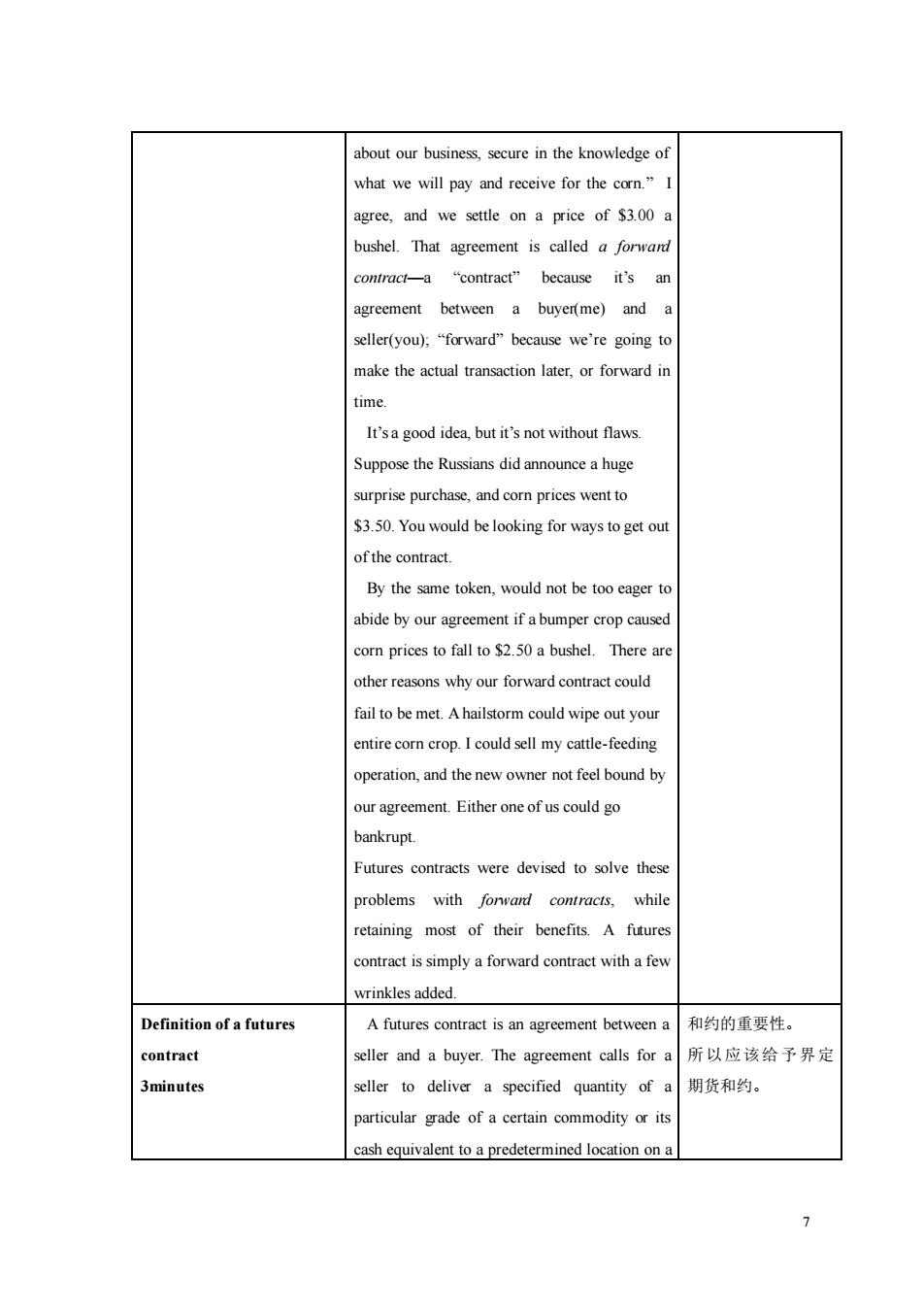
about our business.secure in the knowledge of what we will pay and receive for the corn." agree,and we settle on a price of $300 a bushel.That agreement is called a forward contract-a "contract"because it's an agreement between a buyer(me)and a seller(you);"forward"because we're going to make the actual transaction later,or forward in time. It'sa good idea,but it's not without flaws. Suppose the Russians did announce a huge surprise purchase.ando prices went to $3.50.You would be looking for ways to get out of the contract. By the same token,would not be too eager to abide by our agreement if a bumper crop caused corn prices to fall to $2.50 a bushel.There are other reasons why our forward contract could fail to be met.A hailstorm could wipe out your entire corn crop.I could sell my cattle-feeding operation,and the new owner not feel bound by our agreement.Either one ofus coudgo bankrupt. Futures contracts were devised to solve these problems with fonvand contracts,while retaining most of their benefits.A future contract is simply a forward contract with a few wrinkles added. Definition of a futures A futures contract is an agreement between a 和约的重要性。 contract seller and a buyer.The agreement calls for a 所以应该给予界定 3minutes seller to deliver a specified quantity of a 期货和约。 particular grade of a certain commodity its ash equivalent to a predetermined ocation on a 1
7 about our business, secure in the knowledge of what we will pay and receive for the corn.” I agree, and we settle on a price of $3.00 a bushel. That agreement is called a forward contract—a “contract” because it’s an agreement between a buyer(me) and a seller(you); “forward” because we’re going to make the actual transaction later, or forward in time. It’s a good idea, but it’s not without flaws. Suppose the Russians did announce a huge surprise purchase, and corn prices went to $3.50. You would be looking for ways to get out of the contract. By the same token, would not be too eager to abide by our agreement if a bumper crop caused corn prices to fall to $2.50 a bushel. There are other reasons why our forward contract could fail to be met. A hailstorm could wipe out your entire corn crop. I could sell my cattle-feeding operation, and the new owner not feel bound by our agreement. Either one of us could go bankrupt. Futures contracts were devised to solve these problems with forward contracts, while retaining most of their benefits. A futures contract is simply a forward contract with a few wrinkles added. Definition of a futures contract 3minutes A futures contract is an agreement between a seller and a buyer. The agreement calls for a seller to deliver a specified quantity of a particular grade of a certain commodity or its cash equivalent to a predetermined location on a 和约的重要性。 所以应该给予界定 期货和约
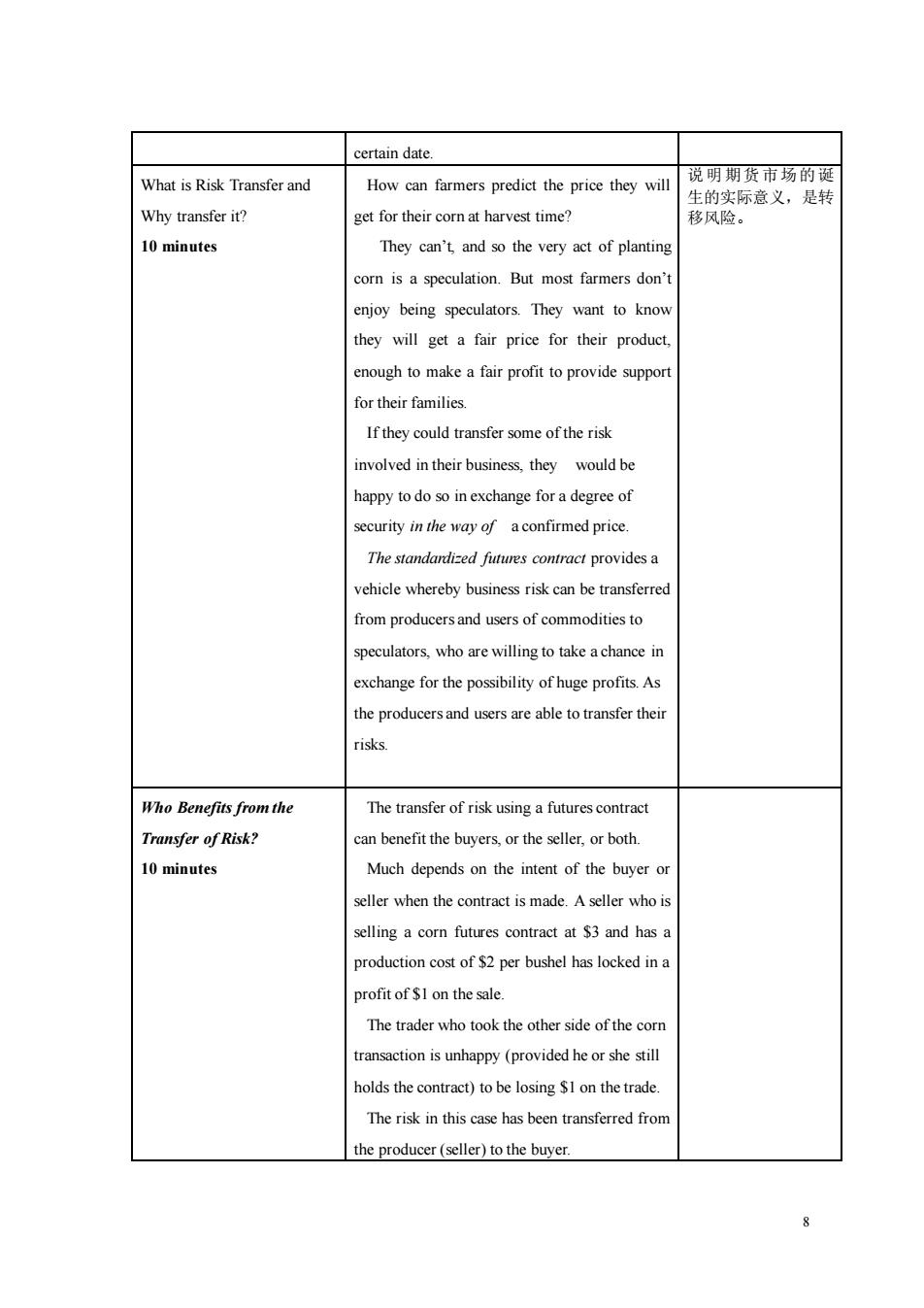
certain date. What is Risk Transfer and How can farmers predict the price they will 说明期货市场的谗 Why transfer it? get for their harvest time? 10 minutes They can't and so the very act of plantins corn is a speculation.But most farmers don't enjoy being speculators.They want to know they will get a fair price for their product enough to make a fair profit to provide suppor for their families If they could transfer some of the risk involved in their business,they would be happy todo so in exchange for a degree of security in the way of aconfirmed price. The standardied futres conract provides a vehicle whereby business risk can be transferred from producersand users of commodities to speculators.who are willing to take achance in exchange for the possibility of huge profits.As the producers and users are able to transfer thei risks Who Benefits from the The transfer of risk using a futures contract Transfer of Risk? can benefit the buyers.or the seller,or both 10 minutes Much depends on the intent of the buyer or seller when the contract is made.A seller who is selling a corn futures contract at $3 and has a production cost of per bushel has locked in profit of $I on the sale The trader who took the other side of the co transaction is unhappy (provided he or she still holds the contract)to be losing $1 on the trade. The risk in this case has been transferred from the producer (seller)to the buyer. 8
8 certain date. What is Risk Transfer and Why transfer it? 10 minutes How can farmers predict the price they will get for their corn at harvest time? They can’t, and so the very act of planting corn is a speculation. But most farmers don’t enjoy being speculators. They want to know they will get a fair price for their product, enough to make a fair profit to provide support for their families. If they could transfer some of the risk involved in their business, they would be happy to do so in exchange for a degree of security in the way of a confirmed price. The standardized futures contract provides a vehicle whereby business risk can be transferred from producers and users of commodities to speculators, who are willing to take a chance in exchange for the possibility of huge profits. As the producers and users are able to transfer their risks. 说明期货市场的诞 生的实际意义,是转 移风险。 Who Benefits from the Transfer of Risk? 10 minutes The transfer of risk using a futures contract can benefit the buyers, or the seller, or both. Much depends on the intent of the buyer or seller when the contract is made. A seller who is selling a corn futures contract at $3 and has a production cost of $2 per bushel has locked in a profit of $1 on the sale. The trader who took the other side of the corn transaction is unhappy (provided he or she still holds the contract) to be losing $1 on the trade. The risk in this case has been transferred from the producer (seller) to the buyer